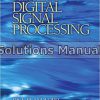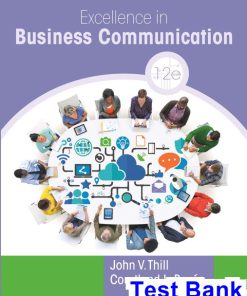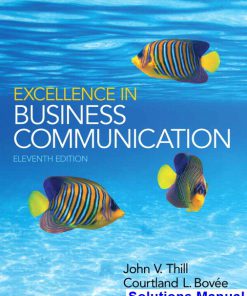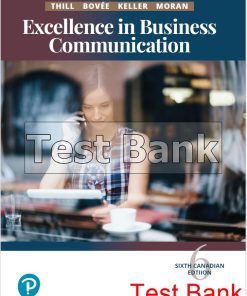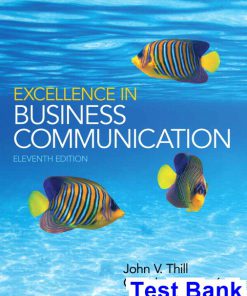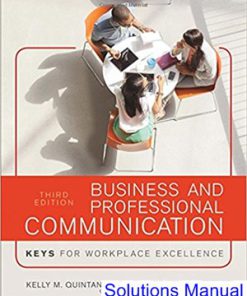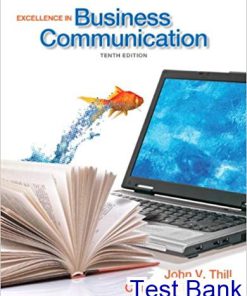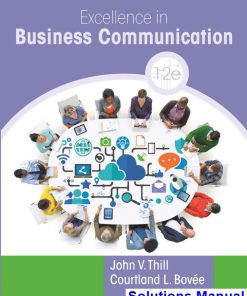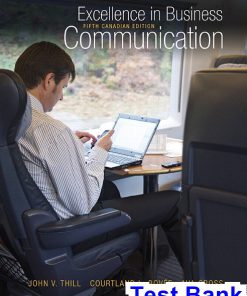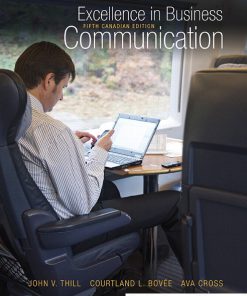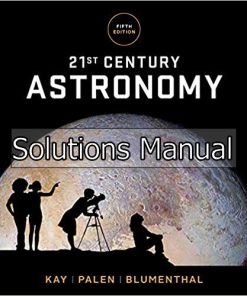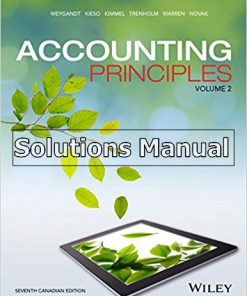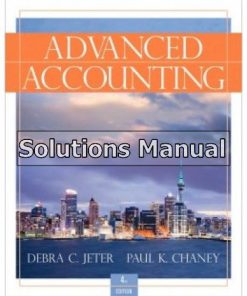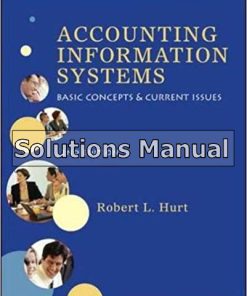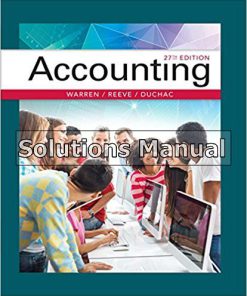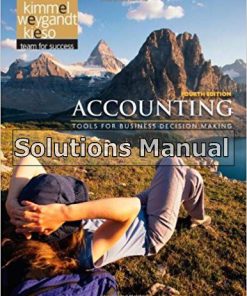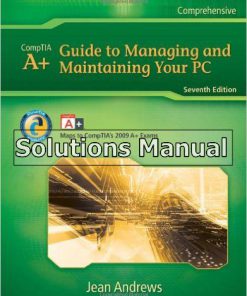Excellence in Business Communication Canadian 6th Edition thill Solutions Manual
$50.00 Original price was: $50.00.$26.50Current price is: $26.50.
Excellence in Business Communication Canadian 6th Edition thill Solutions Manual.
This is completed downloadable of Excellence in Business Communication Canadian 6th Edition thill Solutions Manual
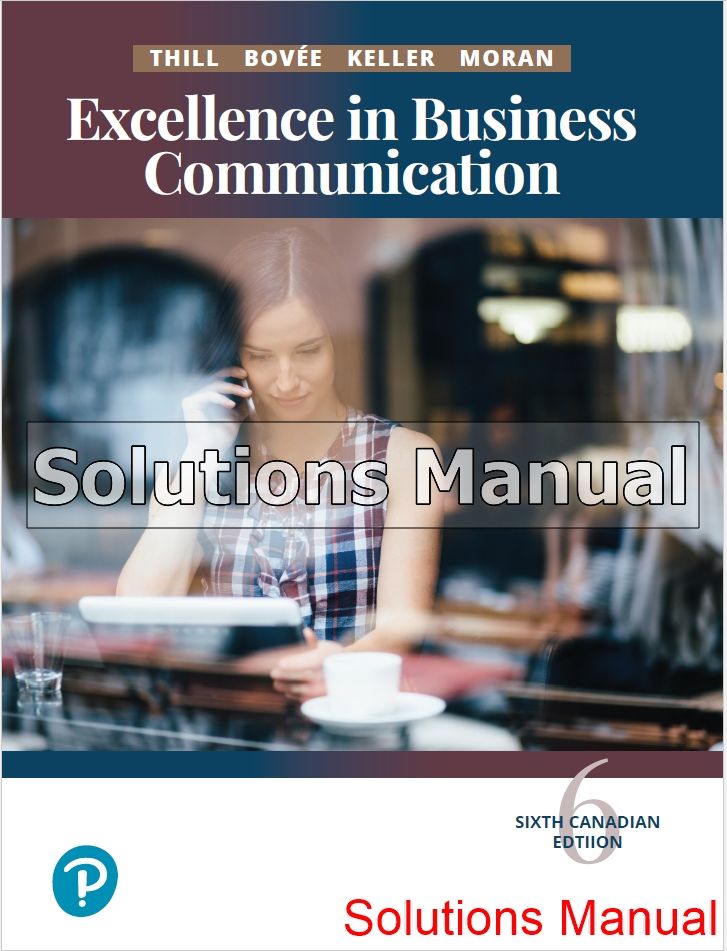
Product Details:
- ISBN-10 : 0134310829
- ISBN-13 : 978-0134310824
- Author: John Thill (Author), Courtland Bovee (Author), Wendy Keller (Author), K. M. Moran (Author)
Excellence in Business Communication has long provided instructors and students with the most current communication strategies and practices used in today’s workplace. This sixth Canadian edition includes up-to-date model documents that reflect the entire spectrum of print and electronic communication media. Students entering today’s workforce are expected to use a wide range of tools, from instant messaging to blogging to podcasting, and Excellence in Business Communication provides the hands-on experience they need to meet employer expectations.
Table of Content:
- Part I Understanding the Foundations of Business Communication
- 1 Achieving Success through Effective Business Communication
- Learning Objectives
- Achieving Career Success through Effective Communication
- 1 Learning Objective
- The Communication Process
- What Employers Expect from You
- 2 Learning Objective
- Characteristics of Effective Communication
- 3 Learning Objective
- Communication in Organizational Settings
- Formal Communication Network
- Informal Communication Network
- Informal Outside Communication
- Understanding the Unique Challenges of Business Communication
- 4 Learning Objective
- I. The Globalization of Business and the Increase in Workforce Diversity
- II. The Evolution of Organizational Structures
- III. The Growing Reliance on Teamwork
- IV. The Increasing Value of Business Information
- V. The Pervasiveness of Technology
- VI. The Need for Increased Cybersecurity and Protection of Privacy
- Barriers to Effective Communication
- Communicating More Effectively on the Job
- 5 Learning Objective
- Strategy 1: Improve Your Business Communication Skills
- Strategy 2: Minimize Distractions
- Strategy 3: Adopt an Audience-Centred Approach
- Understand How Audiences Receive Messages
- Understand How Audiences Decode Messages
- Understand How Audiences Respond to Messages
- Know as much as You can about Your Audience
- Strategy 4: Make Your Feedback Constructive
- Strategy 5: Be Sensitive to Business Etiquette
- Applying What You’ve Learned to the Communication Process
- Using Technology to Improve Business Communication
- 6 Learning Objective
- Understanding the Social Communication Model
- Keeping Technology in Perspective
- Guarding against Information Overload
- Using Technological Tools Productively
- Reconnecting with People Frequently
- Making Ethical Communication Choices
- 7 Learning Objective
- Distinguishing an Ethical Dilemma from an Ethical Lapse
- Ensuring Ethical Communication
- Ensuring Legal Communication
- Applying What You’ve Learned
- Summary of Learning Objectives
- On the Job Performing Communication Tasks at Wave
- Test Your Knowledge
- Apply Your Knowledge
- Practise Your Knowledge
- Exercises
- 1.1 Internal Communication: Planning the Flow
- 1.2 Communication Networks: Formal or Informal?
- 1.3 Ethical Choices: Business Dilemmas
- 1.4 The Changing Workplace: Personal Expression at Work
- 1.5 Internet: Codes of Ethics
- 1.6 Communication Process: Know Your Audience
- 1.7 Ethical Choices: The Go-Between
- 1.8 Communication Etiquette: Training for All?
- 1.9 Teamwork: Know Your Audience
- 1.10 Communication Process: Analyzing Miscommunication
- 1.11 Ethical Choices: Withholding Information
- 1.12 Communication Etiquette: Different Styles
- 2 Communicating in Teams and Mastering Listening and Nonverbal Communication
- Learning Objectives
- Improving Your Performance in Teams
- Types of Teams
- Advantages and Disadvantages of Teams
- 1 Learning Objective
- Characteristics of High Performing Teams
- Group Dynamics
- 2 Learning Objective
- Assuming Team Roles
- Allowing for Team Evolution
- Resolving Conflict
- Overcoming Resistance
- Collaborating on Communication Efforts
- Guidelines for Collaborative Writing
- 3 Learning Objective
- Technologies for Collaborative Writing
- 4 Learning Objective
- Social Networks and Virtual Communities
- Making Your Meetings More Productive
- 5 Learning Objective
- Preparing for Meetings
- Leading and Participating in Meetings
- Using Meeting Technologies
- Improving Your Listening Skills
- Understanding the Listening Process
- 6 Learning Objective
- Recognizing and Understanding Active Listening
- Overcoming Barriers to Effective Listening
- Improving Your Nonverbal Communication Skills
- Recognizing Nonverbal Communication
- 7 Learning Objective
- Using Nonverbal Communication Effectively
- Summary of Learning Objectives
- On the Job Performing Communication Tasks at Royal Bank of Canada
- Test Your Knowledge
- Apply Your Knowledge
- Practise Your Knowledge
- Exercises
- 2.1 Teamwork: Meeting Assessment
- 2.2 Team Communication: Overcoming Barriers
- 2.3 Team Development: Resolving Conflict
- 2.4 Ethical Choices: Dealing with a Meeting Controller
- 2.5 Online Communication: Using Collaboration Technologies
- 2.6 Online Collaboration: Using Collaboration Technologies
- 2.7 Listening Skills: Overcoming Barriers
- 2.8 Nonverbal Communication: Analyzing Written Messages
- 2.9 Nonverbal Communication: Analyzing Body Language
- 2.10 Collaboration: Working in Teams
- 2.11 Culturally Diverse Teams
- 3 Communicating Interculturally
- Learning Objectives
- Understanding the Opportunities and Challenges of Intercultural Communication
- 1 Learning Objective
- The Opportunities in a Global Marketplace
- Advantages of a Multicultural Workforce
- The Challenges of Intercultural Communication
- Developing Cultural Competency
- Understanding the Concept of Culture
- 2 Learning Objective
- Overcoming Ethnocentrism and Stereotyping
- 3 Learning Objective
- Recognizing Cultural Variations
- 4 Learning Objective
- 1. Contextual Differences
- 2. Legal and Ethical Differences
- 3. Social Differences
- 4. Nonverbal Differences
- 5. Age Differences
- 6. Gender Differences
- Improving Intercultural Communication Skills
- Studying Other Cultures
- Studying Other Languages
- Respecting Preferences for Communication Style
- Writing Clearly
- 5 Learning Objective
- Speaking and Listening Carefully
- 6 Learning Objective
- Using Interpreters, Translators, and Translation Software
- Helping Others Adapt to Your Culture
- Summary of Learning Objectives
- On the Job Performing Communication Tasks at IBM
- Test Your Knowledge
- Apply Your Knowledge
- Practise Your Knowledge
- Exercises
- 3.1 Intercultural Sensitivity: Recognizing Variations
- 3.2 Intercultural Communication: Writing for Multiple-Language Audiences
- 3.3 Teamwork: Language and Culture
- 3.4 Intercultural Communication: Studying Cultures
- 3.5 Multicultural Workforce: Bridging Differences
- 3.6 Intercultural Sensitivity: Understanding Attitudes
- 3.7 Culture and Time: Dealing with Variations
- 3.8 Intercultural Communication: Using Interpreters
- 3.9 Internet: Translation Software
- 3.10 Intercultural Communication: Improving Skills
- 3.11 Intercultural Communication: Podcasting
- Part II Applying the Three-Step Writing Process
- 4 Planning Business Messages
- Learning Objectives
- Understanding the Three-Step Writing Process
- 1 Learning Objective
- Optimizing Your Writing Time
- Planning Effectively
- Step 1 in the Writing Process: Planning
- Analyzing the Situation
- Defining Your Purpose
- 2 Learning Objective
- Developing an Audience Profile
- 3 Learning Objective
- Gathering Information
- 4 Learning Objective
- Uncovering Audience Needs
- Providing Required Information
- Be Sure the Information is Accurate
- Be Sure the Information is Ethical
- Be Sure the Information is Relevant
- Selecting the Right Medium
- Oral Media
- Written Media
- Visual Media
- Electronic Media
- Factors to Consider When Choosing Media
- 5 Learning Objective
- Organizing Your Information
- Recognizing the Importance of Good Organization
- 6 Learning Objective
- Defining Your Main Idea
- 7 Learning Objective
- Limiting Your Scope
- Choosing between Direct and Indirect Approaches
- Routine and Positive Messages
- Negative Messages
- Persuasive Messages
- Outlining Your Content
- Start with the Main Idea
- State the Major Points
- Provide Examples and Evidence
- Summary of Learning Objectives
- On the Job Performing Communication Tasks at MaRS
- Test Your Knowledge
- Apply Your Knowledge
- Practise Your Knowledge
- Accident Protection Insurance Plan
- Exercises
- 4.1 Message Planning Skills: Self-Assessment
- 4.2 Planning Messages: General and Specific Purpose
- 4.3 Planning Messages: Specific Purpose
- 4.4 Planning Messages: Audience Profile
- 4.5 Meeting Audience Needs: Necessary Information
- 4.6 Selecting Media: Identifying an Audience
- 4.7 Teamwork: Audience Analysis
- 4.8 Internet: Planning Your Message
- 4.9 Message Organization: Outlining Your Content
- 4.10 Message Organization: Limiting Scope
- 4.11 Message Organization: Choosing an Approach
- 4.12 Message Organization: Audience Focus
- 4.13 Ethical Choices: Providing Information
- 4.14 Three-Step Process: Other Applications
- 5 Writing Business Messages
- Learning Objectives
- Adapting to Your Audience: Being Sensitive to Audience Needs
- 1 Learning Objective
- Using the “You” Attitude
- Maintaining Standards of Etiquette
- Emphasizing the Positive
- Using Bias-Free Language
- Adapting to Your Audience: Building Strong Relationships with Your Audience
- 2 Learning Objective
- Establishing Your Credibility
- Projecting the Company’s Image
- Adapting to Your Audience: Controlling Your Style and Tone
- 3 Learning Objective
- Using a Conversational Tone
- Using Plain Language
- Selecting Active or Passive Voice
- Composing Your Message
- 4 Learning Objective
- Choosing Precise Words
- Using Functional and Content Words Correctly
- Understanding Denotation and Connotation
- Balancing Abstract and Concrete Words
- Finding Words That Communicate Well
- Composing Your Message: Creating Effective Sentences
- 5 Learning Objective
- Choosing from the Four Types of Sentences
- Using Sentence Style to Emphasize Key Thoughts
- Composing Your Message: Crafting Unified, Coherent Paragraphs
- Creating the Elements of the Paragraph
- Topic Sentence
- Support Sentences
- Transitions
- Choosing the Best Way to Develop Each Paragraph
- 6 Learning Objective
- Using Technology to Compose and Shape Your Messages
- Summary of Learning Objectives
- On the Job Performing Communication Tasks at Creative Commons
- Test Your Knowledge
- Apply Your Knowledge
- Practise Your Knowledge
- Exercises
- 5.1 Audience Relationship: Courteous Communication
- 5.2 Audience Relationship: The “You” Attitude
- 5.3 Audience Relationship: Emphasize the Positive
- 5.4 Audience Relationship: Emphasize the Positive
- 5.5 Audience Relationship: Bias-Free Language
- 5.6 Ethical Choices
- 5.7 Message Composition: Controlling Style
- 5.8 Message Composition: Selecting Powerful Words
- 5.9 Message Composition: Selecting Powerful Words
- 5.10 Message Composition: Selecting Powerful Words
- 5.11 Message Composition: Selecting Powerful Words
- 5.12 Message Composition: Selecting Powerful Words
- 5.13 Message Composition: Creating Effective Sentences
- 5.14 Message Composition: Creating Effective Sentences
- 5.15 Message Composition: Writing Effective Paragraphs
- 5.16 Teamwork: Paragraph Techniques
- 5.17 Internet: Plain Language
- 5.18 Message Organization: Transitional Elements
- 5.19 Ethical Choices: Connotative Language
- 5.20 Plain Language
- 6 Completing Business Messages
- Learning Objectives
- Revising Your Message: Evaluating the First Draft
- Evaluating Your Content, Organization, Style, and Tone
- 1 Learning Objective
- Evaluating, Editing, and Revising the Work of Others
- Revising to Improve Readability
- 2 Learning Objective
- Varying Your Sentence Length
- Keeping Your Paragraphs Short
- Using Lists and Bullets to Clarify and Emphasize
- Adding Headings and Subheadings
- Editing for Clarity and Conciseness
- 3 Learning Objective
- Editing for Clarity
- Editing For Conciseness
- 4 Learning Objective
- Using Technology to Revise Your Message
- Producing Your Message
- 5 Learning Objective
- Designing for Readability
- White Space
- Margins and Justification
- Typefaces
- Type Styles
- Designing Multimedia Documents
- Using Technology to Produce Your Message
- Formatting Formal Letters and Memos
- Proofreading Your Message
- 6 Learning Objective
- Distributing Your Message
- 7 Learning Objective
- Summary of Learning Objectives
- On the Job Performing Communication Tasks at Free The Children
- Test Your Knowledge
- Apply Your Knowledge
- Practise Your Knowledge
- Document 6.A
- Document 6.B
- Exercises
- 6.1 Message Readability: Writing Paragraphs
- 6.2 Message Readability: Using Bullets
- 6.3 Revising Messages: Clarity
- 6.4 Revising Messages: Conciseness
- 6.5 Revising Messages: Conciseness
- 6.6 Revising Messages: Conciseness
- 6.7 Revising Messages: Conciseness
- 6.8 Revising Messages: Conciseness
- 6.9 Revising Messages: Modifiers
- 6.10 Revising Messages: Hedging
- 6.11 Revising Messages: Indefinite Starters
- 6.12 Revising Messages: Parallelism
- 6.13 Revising Messages: Awkward References
- 6.14 Revising Messages: Dangling Modifiers
- 6.15 Revising Messages: Noun Sequences
- 6.16 Revising Messages: Sentence Structure
- 6.17 Revising Messages: Camouflaged Verbs
- 6.18 Producing Messages: Design Elements
- 6.19 Web Design: Readability
- 6.20 Teamwork: Peer Review
- 6.21 Proofreading Messages: Email
- 6.22 Ethical Choices: Message Distribution
- Part III Crafting Brief Messages
- 7 Crafting Messages for Electronic Media
- Learning Objectives
- Electronic Media for Business Communication
- 1 Learning Objective
- Compositional Modes for Electronic Media
- Creating Content for Social Media
- Social Networking and Community Participation Sites
- 2 Learning Objective
- Social Networks
- Business Communication Uses of Social Networks
- Strategies for Business Communication on Social Networks
- User-Generated Content Sites
- Community Q&A Sites
- Community Participation Sites
- 3 Learning Objective
- Planning Email Messages
- Writing Email Messages
- Completing Email Messages
- Instant Messaging and Text Messaging
- 4 Learning Objective
- Understanding the Benefits and Risks of IM
- Adapting the Three-Step Process for Successful IM
- Blogging and Microblogging
- 5 Learning Objective
- Understanding the Business Applications of Blogging
- Adapting the Three-Step Process for Successful Blogging
- Microblogging
- Podcasting
- 6 Learning Objective
- Understanding the Business Applications of Podcasting
- Adapting the Three-Step Process for Successful Podcasting
- Summary of Learning Objectives
- On the Job Performing Communication Tasks at Petro-Canada
- Test Your Knowledge
- Apply Your Knowledge
- Practise Your Knowledge
- Message 7.A: Improving IM Skills
- Message 7.B: Drafting Effective Blog Posts
- Exercises
- 7.1 Media: Selecting the Right Medium for Your Message
- 7.2 Social Networking: Creating a Blog Post
- 7.3 Email: Writing Informative Subject Lines
- 7.4 Email: Writing Correctly
- 7.5 IM: Creating a Businesslike Tone
- 7.6 Blogging: Keeping Emotions under Control
- 7.7 Microblogging: Tweeting to Customers
- 7.8 Podcasting: Streamlining Your Content
- 8 Writing Routine and Positive Messages
- Learning Objectives
- Strategy for Routine Requests
- 1 Learning Objective
- Stating Your Request Up Front
- Explaining and Justifying Your Request
- Requesting Specific Action in a Courteous Close
- Common Examples of Routine Requests
- Asking for Information and Action
- Asking for Recommendations
- Making Claims and Requesting Adjustments
- Strategy for Routine Replies and Positive Messages
- 2 Learning Objective
- Starting with the Main Idea
- Providing Necessary Details and Explanation
- Ending with a Courteous Close
- Common Examples of Routine Replies and Positive Messages
- Answering Requests for Information and Action
- Granting Claims and Requests For Adjustment
- 3 Learning Objective
- Responding to a Claim When Your Company is at Fault
- Responding to a Claim When the Customer is at Fault
- Responding to a Claim When a Third Party is at Fault
- Providing Recommendations
- Sharing Routine Information
- 4 Learning Objective
- Announcing Good News
- Fostering Goodwill
- 5 Learning Objective
- Sending Congratulations
- Sending Messages of Appreciation
- Offering Condolences
- Summary of Learning Objectives
- On the Job Performing Communication Tasks at Indigo Books and Music
- Test Your Knowledge
- Apply Your Knowledge
- Practise Your Knowledge
- Document 8.A: Requesting Routine Information from a Business
- Document 8.B: Making Claims and Requests for Adjustment
- Document 8.C: Responding to Claims and Adjustment Requests When the Customer Is at Fault
- Document 8.D: Writing a Letter of Recommendation
- Exercises
- 8.1 Revising Messages: Directness and Conciseness
- 8.2 Revising Messages: Directness and Conciseness
- 8.3 Internet: Analyzing an E-card
- 8.4 Teamwork: Choosing Format and Approach
- 8.5 Revising Messages: Conciseness, Courteousness, and Specificity
- 8.6 Ethical Choice: Customer Service
- 9 Writing Negative Messages
- Learning Objectives
- Using the Three-Step Writing Process for Negative Messages
- 1 Learning Objective
- Step 1: Planning a Negative Message
- Step 2: Writing a Negative Message
- Step 3: Completing a Negative Message
- Using the Direct Approach for Negative Messages
- 2 Learning Objective
- Opening with a Clear Statement of the Bad News
- Providing Reasons and Additional Information
- Closing on a Positive Note
- Using the Indirect Approach for Negative Messages
- 3 Learning Objective
- Opening with a Buffer
- Providing Reasons and Additional Information
- Continuing with a Clear Statement of the Bad News
- Closing on a Respectful Note
- Maintaining High Standards of Ethics and Etiquette
- 4 Learning Objective
- Sending Negative Messages on Routine Business Matters
- Making Negative Announcements on Routine Business Matters
- Rejecting Suggestions and Proposals
- Refusing Routine Requests
- Handling Bad News about Transactions
- Refusing Claims and Requests for Adjustment
- Sending Negative Organizational News
- 5 Learning Objective
- Communicating Under Normal Circumstances
- Communicating in a Crisis
- Sending Negative Employment Messages
- 6 Learning Objective
- Refusing Requests for Employee References and Recommendation Letters
- Refusing Social Networking Recommendation Requests
- Rejecting Job Applications
- Giving Negative Performance Reviews
- Terminating Employment
- Summary of Learning Objectives
- On the Job Performing Communication Tasks at Maple Leaf Foods
- Test Your Knowledge
- Apply Your Knowledge
- Practise Your Knowledge
- Document 9.A: Providing Negative News About Transactions
- Document 9.B: Refusing Requests For Claims and Adjustments
- Document 9.C: Rejecting Job Applications
- Exercises
- 9.1 Selecting the Approach: Various Scenarios
- 9.2 Teamwork: Communicating Bad News
- 9.3 Using Buffers: Practice
- 9.4 Internet: Bad News Strategy
- 9.5 Ethical Choices: Communicating Escalating Rates
- 9.6 Social Media: Responding to Online Messages
- 10 Writing Persuasive Messages
- Learning Objectives
- Using the Three-Step Writing Process for Persuasive Messages
- 1 Learning Objective
- Step 1: Planning a Persuasive Message
- Analyzing The Situation
- Gathering Information
- Selecting The Right Medium
- Organizing Your Information
- Step 2: Writing a Persuasive Message
- Step 3: Completing a Persuasive Message
- Developing Persuasive Business Messages
- 3 Learning Objective
- Strategies for Persuasive Business Messages
- Framing Your Arguments
- Balancing Emotional and Logical Appeals
- Emotional Appeals
- Logical Appeals
- Reinforcing Your Position
- Anticipating Objections
- Common Examples of Persuasive Business Messages
- Persuasive Requests For Action
- Persuasive Presentation of Ideas
- Persuasive Claims and Requests For Adjustment
- Developing Marketing and Sales Messages
- Assessing Audience Needs
- Analyzing Your Competition
- Determining Key Selling Points and Benefits
- Anticipating Purchase Objections
- Applying AIDA or a Similar Model
- Getting Attention
- Building Interest
- Increasing Desire
- Motivating Action
- Writing Promotional Messages For Social Media
- Maintaining High Standards of Ethics, Legal Compliance, and Etiquette
- Summary of Learning Objectives
- On the Job Performing Communication Tasks at Futurpreneur
- Test Your Knowledge
- Apply Your Knowledge
- Practise Your Knowledge
- Document 10.A: Writing Persuasive Requests For Action
- Document 10.B: Writing Persuasive Claims and Requests For Adjustment
- Document 10.C: Writing Sales Letters
- Exercises
- 10.1 Teamwork: Analyzing the Persuasive Strategy
- 10.2 Composing Subject Lines: Capturing Attention
- 10.3 Ethical Choices: Persuasion or Manipulation?
- 10.4 Focusing on Benefits: Features versus Benefits
- 10.5 Message Analysis: Marketing and Sales Messages
- Part IV Preparing Reports and Oral Presentations
- 11 Planning Reports and Proposals
- Learning Objectives
- Applying the Three-Step Writing Process to Reports and Proposals
- 1 Learning Objective
- Analyzing the Situation
- Gathering Information
- Selecting the Right Medium
- Organizing Your Information
- Supporting Your Messages with Reliable Information
- 2 Learning Objective
- Planning Your Research
- Being an Ethical Researcher
- Locating Data and Information
- Evaluating Sources
- Keeping Track of Your Research
- Using Your Research Results
- Analyzing Data
- Quoting, Paraphrasing, and Summarizing Information
- Drawing Conclusions
- Making Recommendations
- Conducting Secondary Research
- 3 Learning Objective
- Finding Information at a Library
- Finding Information Online
- Online Search Tools
- Online Monitoring Tools
- Search Tips
- Documenting Your Sources
- Conducting Primary Research
- 4 Learning Objective
- Conducting Surveys
- Conducting Interviews
- Planning Informational Reports
- 5 Learning Objective
- Organizing Informational Reports
- Organizing Website Content
- Planning Analytical Reports
- 6 Learning Objective
- Focusing on Conclusions
- Focusing on Recommendations
- Focusing on Logical Arguments
- The 2 + 2 = 4 Approach
- The Yardstick Approach
- Planning Proposals
- 7 Learning Objective
- Summary of Learning Objectives
- On the Job Performing Communication Tasks at Dell Inc.
- Test Your Knowledge
- Apply Your Knowledge
- Practise Your Knowledge
- Message for Analysis: Evaluating a Report
- Exercises
- 11.1 Planning: Analyzing the Situation
- 11.2 Planning: Analyzing the Situation
- 11.3 Research: Documenting Sources
- 11.4 Teamwork: Evaluating Sources
- 11.5 Research: Using Research Results
- 11.6 Research: Conducting Secondary Research
- 11.7 Understanding Business Reports and Proposals: Report Classification
- 11.8 Analyzing Data: Calculating the Mean
- 11.9 Research: Conducting Primary Research (Surveys)
- 11.10 Research: Conducting Primary Research (Interviews)
- 11.11 Message Strategies: Informational Reports
- 11.12 Message Strategies: Informational Reports
- 11.13 Message Strategies: Informational Reports
- 11.14 Message Strategies: Analytical Reports
- 11.15 Teamwork: Proposals
- 11.16 Message Strategies: Proposals
- 11.17 Ethical Choices
- 12 Writing Reports and Proposals
- Learning Objectives
- Composing Reports and Proposals
- Adapting to Your Audience
- 1 Learning Objective
- Drafting Report Content
- Creating Report Effectiveness
- 2 Learning Objective
- Report Introduction
- Report Body
- Report Close
- Drafting Proposal Content
- 3 Learning Objective
- Proposal Introduction
- 4 Learning Objective
- Proposal Body
- Proposal Close
- Establishing a Time Perspective
- Helping Readers Find Their Way
- Using Technology to Craft Reports and Proposals
- Writing for Websites and Wikis
- 5 Learning Objective
- Drafting Website Content
- Collaborating on Wikis
- Illustrating Your Reports with Effective Visuals
- Understanding Visual Design Principles
- 6 Learning Objective
- Understanding the Ethics of Visual Communication
- Identifying Points to Illustrate
- 7 Learning Objective
- Selecting the Right Type of Visual
- Visuals for Presenting Data
- Tables
- Line Charts and Surface Charts
- Bar Charts and Pie Charts
- Data Visualization
- Visuals for Presenting Information, Concepts, and Ideas
- Flowcharts and Organization Charts
- Maps and Geographic Information Systems
- Drawings, Diagrams, Infographics, and Photographs
- Animation and Video
- Producing and Integrating Visuals
- Creating Visuals
- Integrating Visuals with Text
- Balancing Illustrations and Words
- Referencing Visuals
- Placing Visuals
- Writing Titles, Captions, and Legends
- Verifying the Quality and Integrity of Your Visuals
- Summary of Learning Objectives
- On the Job Performing Communication Tasks at FedEx
- Test Your Knowledge
- Apply Your Knowledge
- Practise Your Knowledge
- Document 12.A: Documents for Analysis
- Document 12.B
- Exercises
- 12.1 Business Reports: Building Audience Rapport
- 12.2 Composing Reports: Report Content
- 12.3 Teamwork: Graphic Design
- 12.4 Composing Reports: Supporting a Solution
- 12.5 Composing Reports: Navigational Clues
- 12.6 Ethical Choices: Survey Questions
- 12.7 Improving Visuals: Applying the Six Principles of Graphic Design
- 12.8 Writing Reports: Pie Charts
- 12.9 Annual Report: Selecting the Right Visual
- 12.10 Sales Trends: Selecting the Right Chart
- 12.11 Company Expansion: Creating Maps
- 12.12 Presenting Information, Concepts, and Ideas: Photographs
- 13 Completing Reports and Proposals
- Learning Objectives
- Revising Reports and Proposals
- 1 Learning Objective
- Producing Formal Reports
- Prefatory Parts
- Cover
- Title Fly and Title Page
- Letter of Authorization and Letter of Acceptance
- Letter of Transmittal
- 2 Learning Objective
- Table of Contents
- List of Illustrations
- Synopsis or Executive Summary
- 3 Learning Objective
- Text of the Report
- Supplementary Parts
- 4 Learning Objective
- Appendices
- Bibliography
- Index
- Producing Formal Proposals
- Prefatory Parts
- 5 Learning Objective
- Copy of the RFP
- Synopsis or Executive Summary
- Letter of Transmittal
- Text of the Proposal
- Proofreading Reports and Proposals
- Distributing Reports and Proposals
- Summary of Learning Objectives
- On the Job Performing Communication Tasks at the Bill & Melinda Gates Foundation
- Test Your Knowledge
- Apply Your Knowledge
- Practise Your Knowledge
- Document 13.A
- Document 13.B
- Exercises
- 13.1 Teamwork: Creating an Informational Report
- 13.2 Producing Reports: Letter of Transmittal
- 13.3 Internet: Analyzing a Proposal
- 13.4 Ethical Choices: Team Challenge
- 14 Designing and Delivering Oral and Online Presentations
- Learning Objectives
- Building Your Career with Presentations
- 1 Learning Objective
- Planning a Presentation
- 2 Learning Objective
- Analyzing the Situation
- Selecting the Right Medium
- Organizing Your Presentation
- Defining Your Main Idea
- Limiting Your Scope
- Choosing Your Approach
- Preparing Your Outline
- Developing and Writing a Presentation
- Adapting to Your Audience
- Composing Your Presentation
- 3 Learning Objective
- Presentation Introduction
- Getting Your Audience’s Attention
- Building Your Credibility
- Previewing Your Message
- Presentation Body
- Connecting Your Ideas
- Holding Your Audience’s Attention
- 4 Learning Objective
- Presentation Close
- Restating Your Main Points
- Ending with Clarity and Confidence
- Enhancing Your Presentation with Effective Visuals
- 5 Learning Objective
- Choosing Structured or Free-Form Slides
- Designing Effective Slides
- Designing Slides Around a Key Visual
- Writing Readable Content
- Creating Charts and Tables For Slides
- Selecting Design Elements
- Adding Animation and Special Effects
- Completing a Presentation
- Finalizing Slides
- Creating Effective Handouts
- Choosing Your Presentation Method
- Practising Your Delivery
- Delivering a Presentation
- Overcoming Anxiety
- Handling Questions Responsively
- 6 Learning Objective
- Embracing The Backchannel
- 7 Learning Objective
- Giving Presentations Online
- Summary of Learning Objectives
- On the Job Performing Communication Tasks at Telefilm Canada
- Test Your Knowledge
- Apply Your Knowledge
- Practise Your Knowledge
- Document 14.A
- Document 14.B
- Exercises
- 14.1 Mastering Delivery: Analysis
- 14.2 Mastering Delivery: Nonverbal Signals
- 14.3 Ethical Choices
- 14.4 Completing Oral Presentations: Self-Assessment
- 14.5 Creating Effective Slides: Content
- 14.6 Planning a Presentation: Research
- 14.7 Delivering a Presentation: Using Twitter
- 14.8 Business Communications 2.0
- 14.9 Planning and Developing a Presentation: Analyzing a Corporate Speech
- Part V Writing Employment Messages and Interviewing for Jobs
- 15 Building Careers and Writing Résumés
- Learning Objectives
- Building a Career with Your Communication Skills
- Understanding THE Dynamic Workplace
- How Employers View Today’s Job Market
- What Employers Look for in Job Applicants
- Adapting to a Changing Job Market
- What do You Want To Do?
- What do You Have To Offer?
- How can You Make Yourself More Valuable?
- Building an Employment Portfolio
- 1 Learning Objective
- Finding the Ideal Opportunity in Today’s Job Market
- 2 Learning Objective
- Determine the Story of You
- Learn to Think Like an Employer
- Research Industries and Companies of Interest
- Translate Your General Potential into a Specific Solution for Each Employer
- Take the Initiative to Find Opportunities
- Build a Network
- Seek Career Counselling
- Be Professional and Check for Mistakes
- Planning a Résumé
- Analyze Your Purpose and Audience
- Gather Pertinent Information
- Select the Best Medium
- Organize Your Résumé Around Your Strengths
- 3 Learning Objective
- The Chronological Résumé
- The Functional Résumé
- The Combination Résumé
- Address Areas of Concern
- Writing a Résumé
- Keep Your Résumé Honest
- 4 Learning Objective
- Adapt Your Résumé to Your Audience
- Compose Your Résumé
- 5 Learning Objective
- Name and Contact Information
- Introductory Statement
- Education
- Work Experience, Skills, and Accomplishments
- Activities and Achievements
- Personal Data and References
- Completing a Résumé
- 6 Learning Objective
- Revise Your Résumé
- Produce Your Résumé
- Producing a Traditional Printed Résumé
- Printing a Scannable Résumé
- Creating a Plain-Text File of Your Résumé
- Creating a Word File of Your Résumé
- Creating a PDF Version of Your Résumé
- Creating an Online Résumé
- Proofread Your Résumé
- Distribute Your Résumé
- Summary of Learning Objectives
- On the Job Performing Communication Tasks at Tim Hortons
- Test Your Knowledge
- Apply Your Knowledge
- Practise Your Knowledge
- Document 15.A: Writing a Résumé
- Exercises
- 15.1 Work-Related Preferences: Self-Assessment
- 15.2 Internet: Career Match
- 15.3 Teamwork: Action Verbs
- 15.4 Résumé Preparation: Work Accomplishments
- 15.5 Ethical Choices: Describing Teamwork
- 15.6 Completing a Résumé: Electronic Plain-Text Version
- 15.7 It’s Show Time: Creating a Video to Supplement Your Application
- 16 Applying and Interviewing for Employment
- Learning Objectives
- Submitting Your Résumé
- 1 Learning Objective
- Writing Application Letters
- Getting Attention
- Building Interest and Increasing Desire
- Motivating Action
- Following Up After Submitting a Résumé
- Understanding the Interviewing Process
- The Typical Sequence of Interviews
- 2 Learning Objective
- Common Types of Interviews
- Structured Versus Unstructured Interviews
- Panel and Group Interviews
- Behavioural, Situational, Working, and Stress Interviews
- Interview Media
- Telephone
- Email and IM
- Video
- Online
- What Employers Look for in an Interview
- 3 Learning Objective
- Pre-Employment Testing and Background Checks
- Preparing for a Job Interview
- 4 Learning Objective
- I. Learn about the Organization and Your Interviewers
- II. Think Ahead about Questions
- Planning for the Employer’s Questions
- Planning Questions of Your Own
- III. Bolster Your Confidence
- IV. Polish Your Interview Style
- V. Present a Professional Image
- VI. Be Ready When You Arrive
- Interviewing for Success
- 5 Learning Objective
- I. The Warm-Up
- II. The Question-and-Answer Stage
- Dealing with Questions
- Listening to the Interviewer
- Fielding Discriminatory Questions
- III. The Close
- Concluding Gracefully
- Discussing Salary
- Interview Notes
- Following Up After the Interview
- 6 Learning Objective
- Thank-You Message
- Message of Inquiry
- Request for a Time Extension
- Letter of Acceptance
- Letter Declining a Job Offer
- Letter of Resignation
- Summary of Learning Objectives
- On the Job Performing Communication Tasks at Google
- Test Your Knowledge
- Apply Your Knowledge
- Practise Your Knowledge
- Document 16.A: Writing an Application Letter
- Document 16.B: Writing Application Follow-Up Messages
- Document 16.C: Thank-You Message
- Document 16.D: Letter of Inquiry
- Document 16.E: Letter Declining a Job Offer
- Exercises
- 16.1 Career Management: Researching Target Employers
- 16.2 Career Management: Interviewing
- 16.3 Career Management: Understanding Qualifications
- 16.4 Career Management: Interviewing
- 16.5 Ethical Choices: Leaving Your Employer
- Appendix A: Format and Layout of Business Documents
- First Impressions
- Paper
- Customization
- Appearance
- Letters
- Standard Letter Parts
- Heading
- Date
- Inside Address
- Salutation
- Body
- Complimentary Close
- Signature Block
- Additional Letter Parts
- Letter Formats
- Envelopes
- Addressing the Envelope
- Folding to Fit
- International Mail
- Memos
- Reports
- Margins
- Headings
- Page Numbers
- Appendix B: Documentation of Report Sources
- Chicago Humanities Style
- In-Text Citation—Chicago Humanities Style
- Bibliography—Chicago Humanities Style
- APA Style
- In-Text Citation—APA Style
- List of References—APA Style
- MLA Style
- In-Text Citation—MLA Style
- List of Works Cited—MLA Style
- Endnotes
- Name Index
- A
- B
- C
- D
- E
- F
- G
- H
- I
- J
- K
- L
- M
- N
- O
- P
- Q
- R
- S
- T
- U
- V
- W
- X
- Y
- Z
- Subject Index
- A
- B
- C
- D
- E
- F
- G
- H
- I
- J
- K
- L
- M
- N
- O
- P
- Q
- R
- S
- T
- U
- V
- W
- X
- Y
People Also Search:
excellence in business communication canadian thill
excellence in business communication canadian 6th edition thill
excellence in business communication canadian 6th edition download scribd
excellence in business communication canadian 6th edition solution manual download pdf
excellence in business communication canadian 6th edition
Instant download after Payment is complete
You may also like…
Business Communication
Excellence in Business Communication 12th Edition Thill Test Bank
Business Communication
Excellence in Business Communication 12th Edition Thill Solutions Manual
Business Communication
Excellence in Business Communication Canadian 5th Edition Thill Test Bank
Business Communication
Excellence in Business Communication Canadian 5th Edition Thill Solutions Manual
Related products
Solutions Manual
Solutions Manual
Solutions Manual
Solutions Manual
Accounting Information Systems 2nd Edition Hurt Solutions Manual
Solutions Manual


